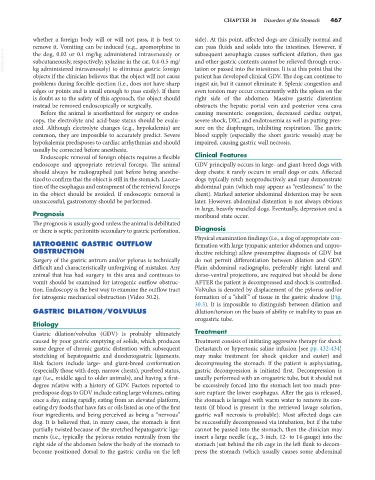Page 495 - Small Animal Internal Medicine, 6th Edition
P. 495
CHAPTER 30 Disorders of the Stomach 467
whether a foreign body will or will not pass, it is best to side). At this point, affected dogs are clinically normal and
remove it. Vomiting can be induced (e.g., apomorphine in can pass fluids and solids into the intestines. However, if
VetBooks.ir the dog, 0.02 or 0.1 mg/kg administered intravenously or subsequent aerophagia causes sufficient dilation, then gas
and other gastric contents cannot be relieved through eruc-
subcutaneously, respectively; xylazine in the cat, 0.4-0.5 mg/
kg administered intravenously) to eliminate gastric foreign
patient has developed clinical GDV. The dog can continue to
objects if the clinician believes that the object will not cause tation or passed into the intestines. It is at this point that the
problems during forcible ejection (i.e., does not have sharp ingest air, but it cannot eliminate it. Splenic congestion and
edges or points and is small enough to pass easily). If there even torsion may occur concurrently with the spleen on the
is doubt as to the safety of this approach, the object should right side of the abdomen. Massive gastric distention
instead be removed endoscopically or surgically. obstructs the hepatic portal vein and posterior vena cava
Before the animal is anesthetized for surgery or endos- causing mesenteric congestion, decreased cardiac output,
copy, the electrolyte and acid-base status should be evalu- severe shock, DIC, and endotoxemia as well as putting pres-
ated. Although electrolyte changes (e.g., hypokalemia) are sure on the diaphragm, inhibiting respiration. The gastric
common, they are impossible to accurately predict. Severe blood supply (especially the short gastric vessels) may be
hypokalemia predisposes to cardiac arrhythmias and should impaired, causing gastric wall necrosis.
usually be corrected before anesthesia.
Endoscopic removal of foreign objects requires a flexible Clinical Features
endoscope and appropriate retrieval forceps. The animal GDV principally occurs in large- and giant-breed dogs with
should always be radiographed just before being anesthe- deep chests; it rarely occurs in small dogs or cats. Affected
tized to confirm that the object is still in the stomach. Lacera- dogs typically retch nonproductively and may demonstrate
tion of the esophagus and entrapment of the retrieval forceps abdominal pain (which may appear as “restlessness” to the
in the object should be avoided. If endoscopic removal is client). Marked anterior abdominal distention may be seen
unsuccessful, gastrostomy should be performed. later. However, abdominal distention is not always obvious
in large, heavily muscled dogs. Eventually, depression and a
Prognosis moribund state occur.
The prognosis is usually good unless the animal is debilitated
or there is septic peritonitis secondary to gastric perforation. Diagnosis
Physical examination findings (i.e., a dog of appropriate con-
IATROGENIC GASTRIC OUTFLOW firmation with large tympanic anterior abdomen and unpro-
OBSTRUCTION ductive retching) allow presumptive diagnosis of GDV but
Surgery of the gastric antrum and/or pylorus is technically do not permit differentiation between dilation and GDV.
difficult and characteristically unforgiving of mistakes. Any Plain abdominal radiographs, preferably right lateral and
animal that has had surgery in this area and continues to dorso-ventral projections, are required but should be done
vomit should be examined for iatrogenic outflow obstruc- AFTER the patient is decompressed and shock is controlled.
tion. Endoscopy is the best way to examine the outflow tract Volvulus is denoted by displacement of the pylorus and/or
for iatrogenic mechanical obstruction (Video 30.2). formation of a “shelf” of tissue in the gastric shadow (Fig.
30.3). It is impossible to distinguish between dilation and
GASTRIC DILATION/VOLVULUS dilation/torsion on the basis of ability or inability to pass an
orogastric tube.
Etiology
Gastric dilation/volvulus (GDV) is probably ultimately Treatment
caused by poor gastric emptying of solids, which produces Treatment consists of initiating aggressive therapy for shock
some degree of chronic gastric distention with subsequent (hetastarch or hypertonic saline infusion [see pp. 432-434]
stretching of hepatogastric and duodenogastric ligaments. may make treatment for shock quicker and easier) and
Risk factors include large- and giant-breed conformation decompressing the stomach. If the patient is asphyxiating,
(especially those with deep, narrow chests), purebred status, gastric decompression is initiated first. Decompression is
age (i.e., middle aged to older animals), and having a first- usually performed with an orogastric tube, but it should not
degree relative with a history of GDV. Factors reported to be excessively forced into the stomach lest too much pres-
predispose dogs to GDV include eating large volumes, eating sure rupture the lower esophagus. After the gas is released,
once a day, eating rapidly, eating from an elevated platform, the stomach is lavaged with warm water to remove its con-
eating dry foods that have fats or oils listed as one of the first tents (if blood is present in the retrieved lavage solution,
four ingredients, and being perceived as being a “nervous” gastric wall necrosis is probable). Most affected dogs can
dog. It is believed that, in many cases, the stomach is first be successfully decompressed via intubation, but if the tube
partially twisted because of the stretched hepatogastric liga- cannot be passed into the stomach, then the clinician may
ments (i.e., typically the pylorus rotates ventrally from the insert a large needle (e.g., 3-inch, 12- to 14-gauge) into the
right side of the abdomen below the body of the stomach to stomach just behind the rib cage in the left flank to decom-
become positioned dorsal to the gastric cardia on the left press the stomach (which usually causes some abdominal

